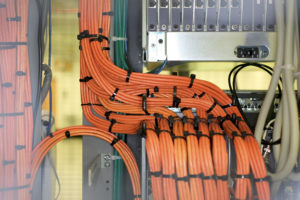
This article will demonstrate the basics of horizontal cabling.
Complicated and particular cabling is required in computer networks, especially in business or academic environments. The cables used in network cabling must be created from specific materials. Horizontal cabling is one of the primary cabling methods used in today’s structured cabling system. So, what type of cables are appropriate for horizontal cabling? This article will demonstrate the basics of horizontal cabling.
What Goes into Horizontal Cabling?
Horizontal cabling expands from a telecommunications room (TR) to the individual workstation outlets or a Work Area Outlet (WAO). It is typically installed in a star topology that connects each work area to the telecommunications room. It consists of the telecommunications outlet, a consolidation point (optional), a horizontal cable, mechanical terminations, and patch cords, or jumpers, stationed in the telecommunications room.
Furthermore, horizontal cabling is different from backbone cabling when it comes to covering various telecommunication service areas. Unlike backbone cabling, horizontal cabling links telecommunication rooms to individual outlets on the ground. There are situations where horizontal cables for workstations on one floor can be directed to a TR in a different room. In addition, horizontal cabling must adapt to specific fire-rating specifications, which differ from project to project.
What are the Cables for Horizontal Cabling?
The most common type used for Horizontal runs is copper cabling; however, fiber optic and coaxial cables can also be utilized. Keep in mind that regardless of the cable type, horizontal cabling should be limited to 90 meters in length between the WAO and the termination point in the telecommunications room to satisfy the TIA standards. The patch cords for linking the patch panel to hubs and switches in the TR must be no longer than 6 meters in the distance. Lastly, the cables connecting users’ computers to the outlets should be restricted to 3 meters.
Since horizontal cabling is an essential component of structured cabling, it’s vital to have FiberPlus design and install your cabling infrastructure.
Get in Touch with FiberPlus
FiberPlus has been providing data communication solutions for over 25 years in the Mid-Atlantic Region for a number of different markets. What began as a cable installation company for Local Area Networks has grown into a leading provider of innovative technology solutions improving the way our customers communicate and keeping them secure. Our solutions now include:
- Structured Cabling (Fiberoptic, Copper and Coax for inside and outside plant networks)
- Electronic Security Systems (Access Control & CCTV Solutions)
- Wireless Access Point installations
- Public Safety DAS – Emergency Call Stations
- Audio/Video Services (Intercoms and Display Monitors)
- Support Services
- Specialty Systems
- Design/Build Services
- UL2050 Certifications and installations for Secure Spaces
FiberPlus promises the communities in which we serve that we will continue to expand and evolve as new technology is introduced within the telecommunications industry.